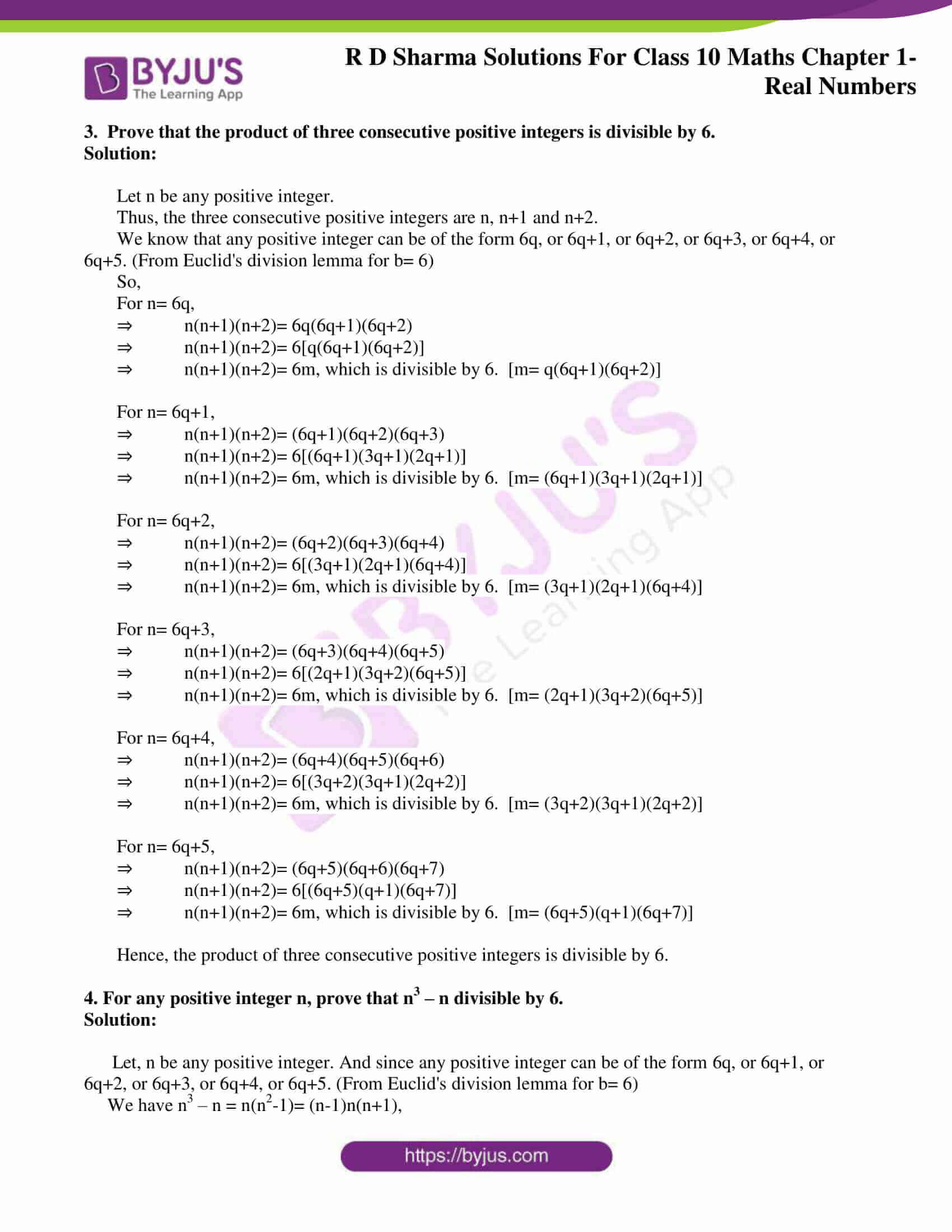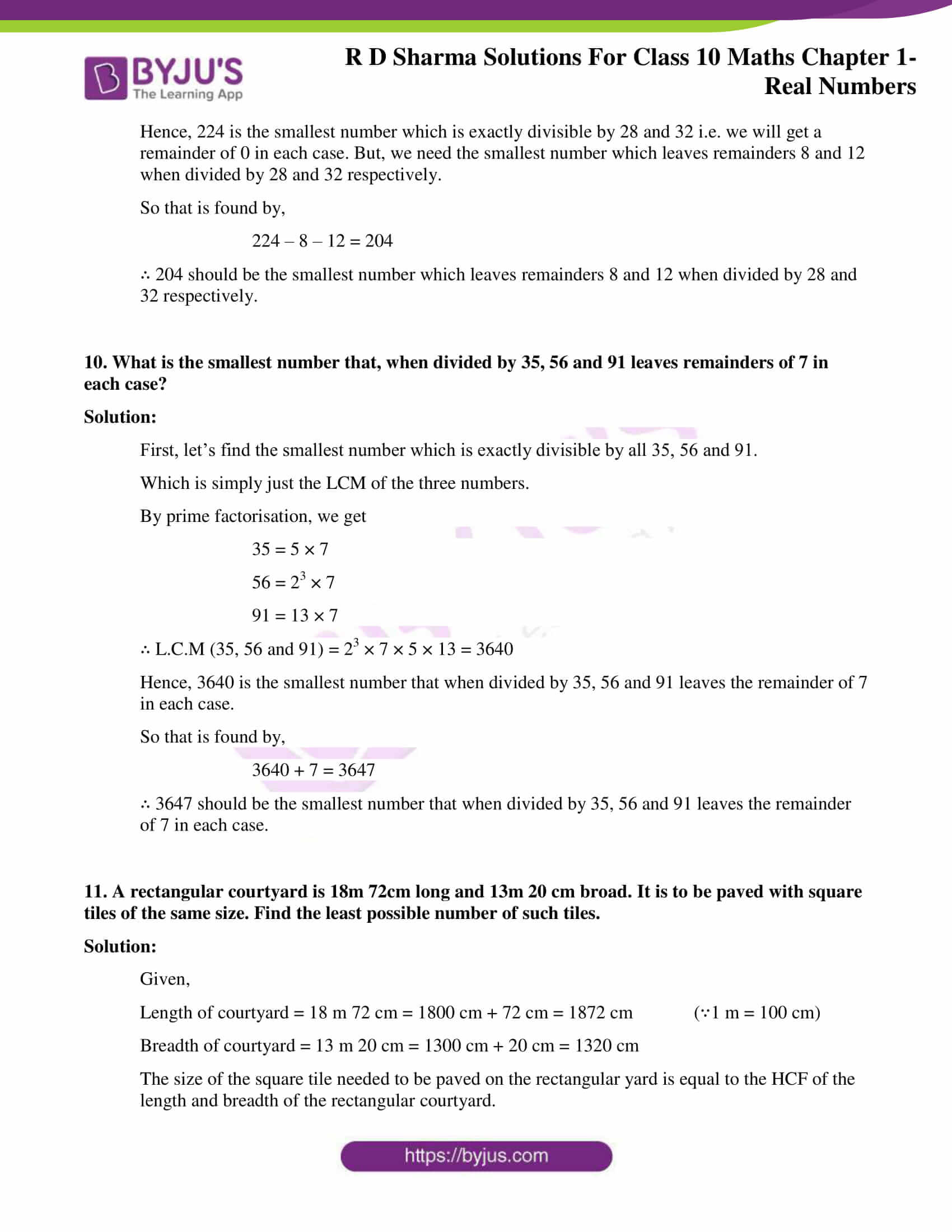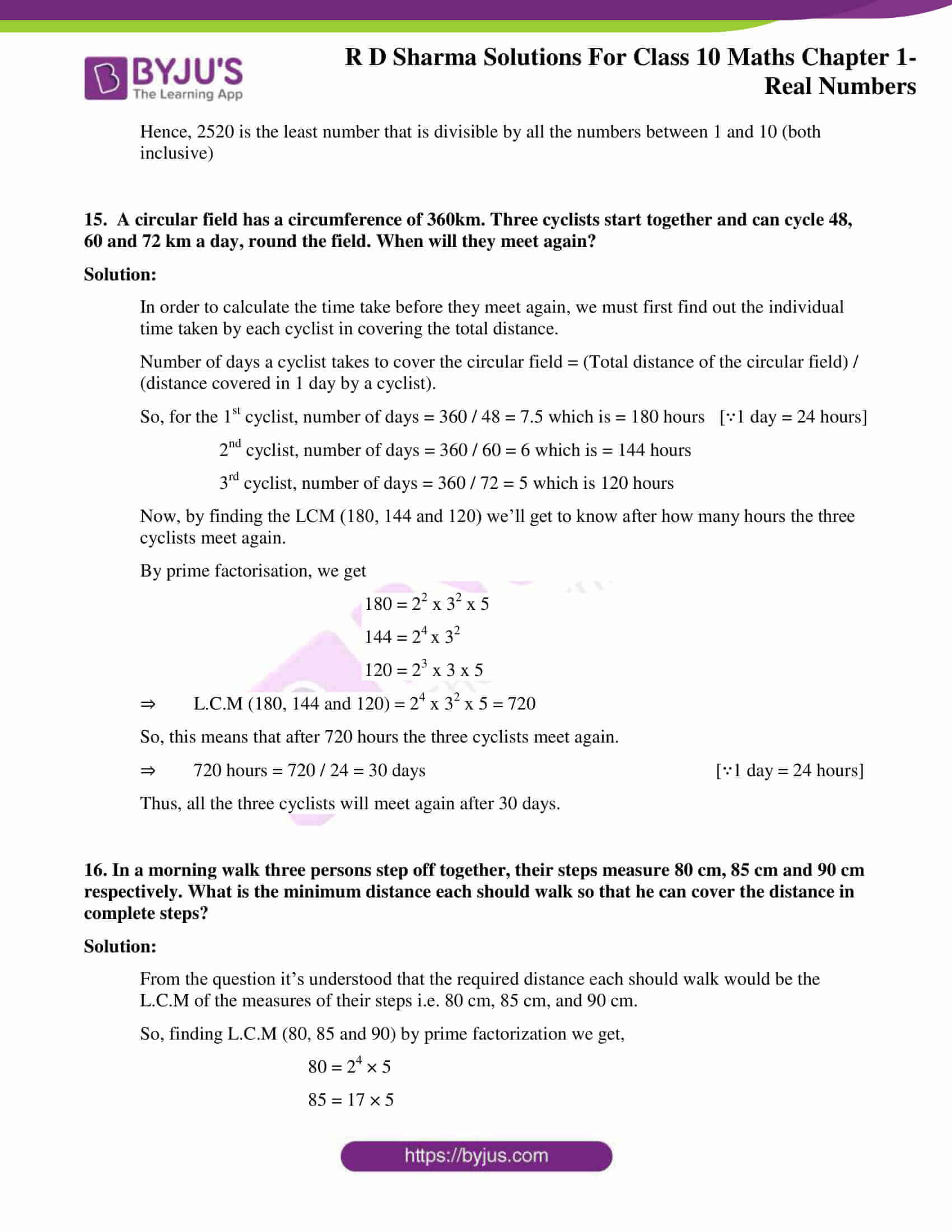RD Sharma Solutions Class 10 Maths Chapter 1 – Free PDF Download Updated for 2023-24
RD Sharma Solutions for Class 10 Maths Chapter 1 Real Numbers provides comprehensive answers to the textbook exercise questions, which are prepared by the subject experts at BYJU’S to help students learn the concepts effectively. The solutions are prepared with the aim of providing the best study material to students to prepare well for the board exam. Students can download the solutions PDF from the links provided here and study without any time constraints. RD Sharma Solutions are the best study resource for clearing the doubts of students that they come across while revising textbook problems.
Students can find precise answers to the questions present in Chapter 1 of Maths RD Sharma Solutions Class 10. Here, students are provided with essential concepts which are helpful in pursuing a career in the field of Mathematics in future. Students can rely on these solutions to prepare well and achieve good academic results. The Solution of RD Sharma Class 10 Chapter 1 is designed by professional teachers in accordance with the latest CBSE syllabus for 2023-24.
RD Sharma for Class 10 Maths Chapter 1 Real Numbers Here
Access Answers to D Sharma Solutions for Class 10 Maths Chapter 1 – Real Numbers
Exercise 1.1 Page No: 1.10
1. If a and b are two odd positive integers such that a > b, then prove that one of the two numbers (a+b)/2 and (a-b)/2 is odd, and the other is even.
Solution:
We know that any odd positive integer is of form 4q+1 or 4q+3 for some whole number q.
Now that it’s given a > b
So, we can choose a= 4q+3 and b= 4q+1.
∴ (a+b)/2 = [(4q+3) + (4q+1)]/2
⇒ (a+b)/2 = (8q+4)/2
⇒ (a+b)/2 = 4q+2 = 2(2q+1) which is clearly an even number.
Now, doing (a-b)/2
⇒ (a-b)/2 = [(4q+3)-(4q+1)]/2
⇒ (a-b)/2 = (4q+3-4q-1)/2
⇒ (a-b)/2 = (2)/2
⇒ (a-b)/2 = 1, which is an odd number.
Hence, one of the two numbers (a+b)/2 and (a-b)/2 is odd, and the other is even.
2. Prove that the product of two consecutive positive integers is divisible by 2.
Solution:
Let’s consider two consecutive positive integers as (n-1) and n.
∴ Their product = (n-1) n
= n2 – n
We know that any positive integer is of form 2q or 2q+1. (From Euclid’s division lemma for b= 2)
So, when n= 2q
We have,
⇒ n2 – n = (2q)2 – 2q
⇒ n2 – n = 4q2 -2q
⇒ n2 – n = 2(2q2 -q)
Thus, n2 – n is divisible by 2.
Now, when n= 2q+1
We have,
⇒ n2 – n = (2q+1)2 – (2q-1)
⇒ n2 – n = (4q2+4q+1 – 2q+1)
⇒ n2 – n = (4q2+2q+2)
⇒ n2 – n = 2(2q2+q+1)
Thus, n2 – n is divisible by 2 again.
Hence, the product of two consecutive positive integers is divisible by 2.
3. Prove that the product of three consecutive positive integers is divisible by 6.
Solution:
Let n be any positive integer.
Thus, the three consecutive positive integers are n, n+1 and n+2.
We know that any positive integer can be of form 6q, or 6q+1, 6q+2, 6q+3, 6q+4, or 6q+5. (From Euclid’s division lemma for b= 6)
So,
For n= 6q,
⇒ n(n+1)(n+2)= 6q(6q+1)(6q+2)
⇒ n(n+1)(n+2)= 6[q(6q+1)(6q+2)]
⇒ n(n+1)(n+2)= 6m, which is divisible by 6. [m= q(6q+1)(6q+2)]
For n= 6q+1,
⇒ n(n+1)(n+2)= (6q+1)(6q+2)(6q+3)
⇒ n(n+1)(n+2)= 6[(6q+1)(3q+1)(2q+1)]
⇒ n(n+1)(n+2)= 6m, which is divisible by 6. [m= (6q+1)(3q+1)(2q+1)]
For n= 6q+2,
⇒ n(n+1)(n+2)= (6q+2)(6q+3)(6q+4)
⇒ n(n+1)(n+2)= 6[(3q+1)(2q+1)(6q+4)]
⇒ n(n+1)(n+2)= 6m, which is divisible by 6. [m= (3q+1)(2q+1)(6q+4)]
For n= 6q+3,
⇒ n(n+1)(n+2)= (6q+3)(6q+4)(6q+5)
⇒ n(n+1)(n+2)= 6[(2q+1)(3q+2)(6q+5)]
⇒ n(n+1)(n+2)= 6m, which is divisible by 6. [m= (2q+1)(3q+2)(6q+5)]
For n= 6q+4,
⇒ n(n+1)(n+2)= (6q+4)(6q+5)(6q+6)
⇒ n(n+1)(n+2)= 6[(3q+2)(3q+1)(2q+2)]
⇒ n(n+1)(n+2)= 6m, which is divisible by 6. [m= (3q+2)(3q+1)(2q+2)]
For n= 6q+5,
⇒ n(n+1)(n+2)= (6q+5)(6q+6)(6q+7)
⇒ n(n+1)(n+2)= 6[(6q+5)(q+1)(6q+7)]
⇒ n(n+1)(n+2)= 6m, which is divisible by 6. [m= (6q+5)(q+1)(6q+7)]
Hence, the product of three consecutive positive integers is divisible by 6.
4. For any positive integer n, prove that n3 – n is divisible by 6.
Solution:
Let n be any positive integer. And since any positive integer can be of form 6q, or 6q+1, 6q+2, 6q+3, 6q+4, or 6q+5. (From Euclid’s division lemma for b= 6)
We have n3 – n = n(n2-1)= (n-1)n(n+1),
For n= 6q,
⇒ (n-1)n(n+1)= (6q-1)(6q)(6q+1)
⇒ (n-1)n(n+1)= 6[(6q-1)q(6q+1)]
⇒ (n-1)n(n+1)= 6m, which is divisible by 6. [m= (6q-1)q(6q+1)]
For n= 6q+1,
⇒ (n-1)n(n+1)= (6q)(6q+1)(6q+2)
⇒ (n-1)n(n+1)= 6[q(6q+1)(6q+2)]
⇒ (n-1)n(n+1)= 6m, which is divisible by 6. [m= q(6q+1)(6q+2)]
For n= 6q+2,
⇒ (n-1)n(n+1)= (6q+1)(6q+2)(6q+3)
⇒ (n-1)n(n+1)= 6[(6q+1)(3q+1)(2q+1)]
⇒ (n-1)n(n+1)= 6m, which is divisible by 6. [m= (6q+1)























































Very good